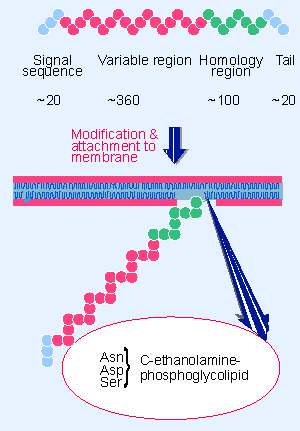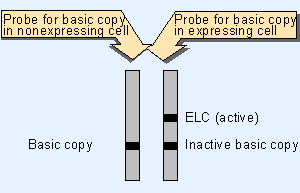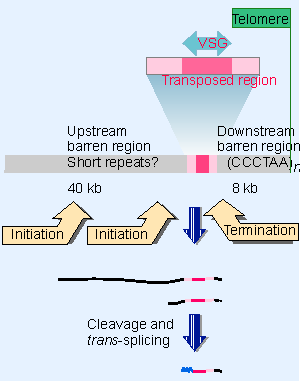7. Trypanosomes rearrange DNA to express new surface antigens
17.7 Trypanosomes rearrange DNA to express new surface antigens |
 |
Figure 17.13 A trypanosome passes through several morphological forms when its life cycle alternates between a tsetse fly and mammalian host. |
Sleeping sickness in man (and a related disease in cows) is caused by infection with African trypanosomes. The unicellular parasite follows the life cycle illustrated in Figure 17.13, in which it alternates between tsetse fly and mammal. The trypanosome may be transferred either to or from the fly when it bites a mammal.
During its life cycle, the parasite undergoes several morphological and biochemical changes. The most significant biochemical change is in the variable surface glycoprotein (VSG), the major component of the surface coat. The coat covers the plasma membrane and consists of a monolayer of 5 V10 106 molecules of a single VSG, which is the only antigenic structure exposed on the surface. A trypanosome expresses only one VSG at any time, and its ability to change the VSG is responsible for its survival through the fly-mammal infective cycle.
Consider the cycle as starting when a fly gains a trypanosome by biting an infected mammal. The trypanosome enters the gut of the fly in the "procyclic form," and loses its VSG. After about three weeks, its progeny differentiate into the "metacyclic form," which re-acquires a VSG coat. This form is transmitted to the mammalian bloodstream during a bite by the fly. The trypanosome multiplies in the mammalian bloodstream. Its progeny continue to express the metacyclic VSG for about a week. Then a new VSG is synthesized, and further transitions occur every 1 V2 weeks.
Each of the successive VSG species is immunologically distinct. As a result, the antigen presented to the mammalian immune system is constantly changing. The process of transition is called antigenic variation. The immune response of the organism always lags behind the change in surface antigen, so that the trypanosome evades immune surveillance, and thereby perpetuates itself indefinitely. Each transition of the VSG is accompanied by a new wave of parasitemia, with symptoms of fever, rash, etc.; the parasites eventually invade the central nervous system, after which the mammalian host becomes progressively more lethargic and eventually comatose.
Trypanosomes vary in their host range. The best investigated species is a variety of Trypanosoma brucei that grows well on laboratory animals (although not on man). Laboratory strains of T. brucei switch VSGs spontaneously at a rate of 10 V4 V 10 V6 per division. Switching occurs independently of the host immune system. In effect, new variants then are selected by the host, because it mounts a response against the old VSG, but fails to recognize and act against the new VSG (for review see Boothroyd, 1985; Donelson and Rice-Ficht, 1985).
 |
Figure 17.14 The C-terminus of VSG is cleaved and covalently linked to the membrane through a glycolipid. |
A general view of VSG structure is depicted in Figure 17.14. A nascent VSG is ~500 amino acids long; it has an N-terminal signal sequence, followed by a long variable region that provides the unique antigenic determinant, and a C-terminal homology region ending in a short hydrophobic tail. The nascent VSG is processed at both ends to give the mature form. The signal sequence is cleaved during secretion. The hydrophobic tail is removed before the VSG reaches the outside surface. The new C-terminus is covalently attached to the trypanosome membrane; three types of homology region are distinguished according to the C-terminal amino acid.
The VSG is attached to the membrane via a phosphoglycolipid. As a result, VSG can be released from the membrane by an enzyme that removes fatty acid. This reaction (which is used in purifying the VSG) may be important in vivo in allowing one VSG to be replaced by another on the surface of the trypanosome.
How many varieties of VSG can be expressed by any one trypanosome? It is not clear that any limit is encountered before death of the host. A single trypanosome can make at least 100 VSGs sufficiently different in sequence that antibodies against any one do not react against the others.
VSG variation is coded in the trypanosome genome. Every individual trypanosome carries the entire VSG repertoire of its strain. Diversity therefore depends on changing expression from one preexisting gene to another.
The trypanosome genome has an unusual organization, consisting of a large number of segregating units. In addition to an unknown number of chromosomes, it contains ~100 "minichromosomes," each containing ~50 V150 kb of DNA. Hybridization experiments identify ~1000 VSG genes, scattered among all size classes of chromosomal material.
Each VSG is coded by a basic-copy gene. These genes can be divided into two classes according to their chromosomal location:
- Telomeric genes lie within 5 V15 kb of a telomere. There could be >200 of these genes if every telomere has one.
- Internal genes reside within chromosomes (more formally, they lie >50 kb from a telomere).
As might be expected of a large family of genes, individual basic copies show varying degrees of relationship, presumably reflecting their origin by duplication and variation. Genes that are closely related, and which provoke the same antigenic response, are called isogenes.
How is a single VSG gene selected for expression? Only one VSG gene is transcribed in a trypanosome at a given time. The copy of the gene that is active is called the expression-linked copy (ELC). It is said to be located at an expression site. An expression site has a characteristic property: it is located near a telomere.
 |
Figure 17.15 VSG genes may be created by duplicative transfer from an internal or telomeric basic copy into an expression site, or by activating a telomeric copy that is already present at a potential expression site. |
These features immediately suggest that the route followed to select a gene for expression depends on whether the basic copy is itself telomeric or internal. The two types of event that can create an ELC are summarized in Figure 17.15.
- The expression site remains the same, but the ELC is changed. Duplication transfers the sequence of a basic copy to replace the sequence currently occupying the expression site. Either internal or telomeric copies may be activated directly by duplication into the expression site. The substitution of one cassette for another does not interfere with the activity of the site.
- The expression site is changed. Activation in situ is available only to a sequence already present at a telomere. When a telomeric site is activated in situ, the previous expression site must cease to be active and the new site now becomes the expression site.
Internal basic copies probably can be copied into non-expressed telomeric locations as well as into expression sites. So an internal gene could be activated by a two-stage process, in which first it is transposed to a non-expressed telomere, and then this site is activated.
We can follow the fate of genes involved in activation by restriction mapping. A probe representing an expressed sequence can be derived from the mRNA. Then we can determine the status of genes corresponding to the probe. We see different results for internal and telomeric basic copy genes:
- Activation of an internal gene requires generation of new sequences. Figure 17.16 shows that when an internal gene is activated, a new fragment is found. The original basic-copy gene remains unaltered; the new fragment is generated by the duplication of the gene into a new context (where the sites recognized by the restriction enzyme are in the surrounding sequences and therefore generate a distinct fragment). The new fragment identifies an ELC, located close to a telomere. The ELC appears when the gene is expressed and disappears when the gene is switched off. Duplication into the ELC is the only pathway by which an internal basic copy can be generated.

Figure 17.17 Telomeric basic copies can be activated in situ; the size of the restriction fragment may change (slightly) when the telomere is extended. - Activation of a telomeric gene can occur in situ. Figure 17.17 shows that when a telomeric gene is activated, the gene number need not change. The structure of the gene may be essentially unaffected as detected by restriction mapping. The size of the fragment containing the gene may vary slightly, because the length of the telomere is constantly changing. Telomeric basic copies can also be activated by the same duplication pathway as internal copies; in this case, the basic copy remains at its telomere, while an expression-linked copy appears at another telomere (generating a new fragment as illustrated for internal basic copies in Figure 17.16).
 |
Figure 17.16 Internal basic copies can be activated only by generating a duplication of the gene at an expression-linked site |
Formation of the ELC occurs by gene conversion. Like the switch in yeast mating type, it represents the replacement of a "cassette" at the active (telomeric) locus by a stored cassette. The VSG system is more versatile in the sense that there are many potential donor cassettes (and also more than a single potential recipient site).
Almost all switches in VSG type involve replacement of the ELC by a pre-existing silent copy. Some exceptional cases have been found, however, in which the sequence of the ELC does not match any of the repertoire of silent copies in the genome. A new sequence may be created by a series of gene conversions in which short stretches of different silent copies are connected. This resembles the mechanism for generating diversity in chicken λ immunoglobulins (see 24 Immune diversity). Although rare, such occurrences extend VSG diversity.
How many expression sites are there? So far only a few expression sites have been observed, which suggests that only a subset of telomeres can function in this capacity, but it is possible that any telomere can be used (although some may be preferred to others).
 |
Figure 17.18 The expression-linked copy of a VSG gene contains barren regions on either side of the transposed region, which extends from ~1000 bp upstream of the VSG coding region to a site near the 3 F terminus of the mRNA. |
The structure of the VSG gene at the ELC is unusual, as illustrated in Figure 17.18. The length of DNA transferred into the ELC is 2500 V3500 bp, somewhat longer than the VSG-coding region of 1500 bp. Most of the additional length is upstream of the gene. The crossover points at which the duplicated sequence joins the ELC do not appear to be precisely determined.
Analysis of events at the 5′ end of the VSG mRNA is complicated by the fact that the mature RNA starts with a 35 base sequence coded elsewhere, and added in trans to the newly synthesized 5′ end (see 22 Nuclear splicing and RNA processing). The signals for initiating and terminating transcription (and sometimes also the end of the coding region itself) are provided by the sequences flanking the transposed region. In fact, transcription may be initiated several kb upstream of the VSG gene itself. Promoters have been mapped at 4 kb and ~60 kb upstream of the VSG sequence. Use of the more distant promoter generates a transcript that contains other genes as well as the active VSG. The VSG sequence (and other gene sequences) must be released by cleavage from the transcript, after which the 35 base spliced leader is added to the 5′ end.<
On either side of the transposed region are extensive regions that are not cut by restriction enzymes. These "barren regions" consist of repetitive DNA; they extend some 8 kb downstream and for up to 40 kb upstream of the ELC. Going downstream, the barren region consists largely of repeats of the sequence CCCTAA, and extends to the telomere. Proceeding upstream, it may also consist of repetitive sequences, but their nature is not yet clear. The existence of the barren regions, however, has been an impediment to characterizing ELC genes by cloning.
Activation of an expression site involves a change in the region upstream of the transcription unit. When the promoter of an ELC is substituted by another promoter, the capacity of the ELC to be inactivated and activated is not altered, and therefore cannot be the result of control by trans-acting factors at the promoter. The regulatory event could be an alteration in chromatin structure, initiated in the upstream region (for review see Borst, 1986).
The order in which VSG genes are expressed during an infection is erratic, but not completely random. This may be an important feature in survival of the trypanosome. If VSG genes were used in a predetermined order, a host could knock out the infection by mounting a reaction against one of the early elements. The need for unpredictability in the production of VSGs may be responsible for the evolution of a system with many donor sequences and multiple recipients.
Antigenic variation is not a unique phenomenon of trypanosomes. The bacterium Borrelia hermsii causes relapsing fever in man and analogous diseases in other mammals. The name of the disease reflects its erratic course: periods of illness are spaced by periods of relief. When the fevers occur, spirochetes are found in the blood; they disappear during periods of relief, as the host responds with specific antibodies.
Like the trypanosomes, Borrelia survives by altering a surface protein, called the variable major protein (VMP). Changes in the VMP are associated with rearrangements in the genome. The active VMP is located near the telomere of a linear plasmid. We do not yet know the extent of the coded variants or the mechanisms used to alter their expression. It is intriguing, however, that the eukaryote Trypanosoma and the prokaryote Borrelia should both rely upon antigenic variation as a means for evading immune surveillance.
| Reviews | |
| Boothroyd, J. C. (1985). Antigenic variation in African trypanosomes. Ann. Rev. Immunol. 39, 475-502. | |
| Borst, P. (1986). Discontinuous transcription and antigenic variation in trypanosomes. Ann. Rev. Biochem 55, 701-732. | |
| Donelson, J. E. and Rice-Ficht, A. C. (1985). Molecular biology of trypanosome antigenic variation. Microbiol. Rev. 49, 107-125. | |